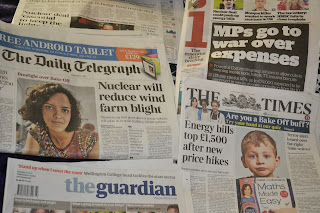This brief states that the news must be taken from the 22nd October 2013, so to receive a varied amount of news I purchased a range of broadsheet and middle market papers.
When researching into the news I found that newspapers contain a certain political identity and opinion on events and social issues. Such as "The Sun" which usually supports left wing politics (Labour) and values, this is due to the fact that the paper's target audience is the working class and as a tabloid newspaper it targets this audience by using shocking headlines, large pictures and minimal text. This ensures that the audience gains interest from the larger imagery rather than heavy blocks of text which they would not want to read. The Sun's content also includes a larger portion of sport and celebrity gossip and the use of sans serif fonts which are not usually found in broadsheet newspapers. Papers such as "The Daily Telegraph" support right wing views (conservative) and opinions which tend to support the middle class, this is also shown by the heavy amounts of text and usually smaller images. The header text on the front of the newspaper is also in black which contrasts the tabloids "red top" bold headers. The content of these newspapers also varies due to including political, scientific and environmental debates which would not be seen in tabloid newspapers, therefore appealing and targeting a middle class audience which would stereotypically be interested in these subjects.
Due to television and now online resources there are many formats news can be viewed and read other than traditional forms of newspapers. When discussing as a group we found that as 18-25 year olds we were more familiar with television and websites which report news and as a whole very little individuals bought newspapers. Websites which were mentioned included; BBC news, Google News, Reddit, BING, Yahoo!, Sky News, Fox, CNN, ESPN and versions of social networks such as Facebook and Twitter.
Tv programmes that were mentioned included a range of traditional news reports and also comedy versions of the news which would attract young people to be aware both nationally and internationally. A list of those that were mentioned included; BBC news, ITV news, Sky, The One Show, ESPN, 6 o'clock news, 10 o'clock news, This Morning, Daybreak, 8 Out Of 10 Cats, Loose Women, Mock The Week, Newsround, Have I Got News For You, 10 o'clock Live, Russell Howard's Good News and also Question Time.


No comments:
Post a Comment